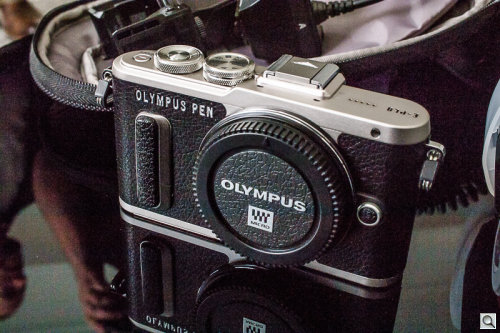C O N T E N T S
Photo Corners headlinesarchivemikepasini.com
![]()
A S C R A P B O O K O F S O L U T I O N S F O R T H E P H O T O G R A P H E R
![]()
Enhancing the enjoyment of taking pictures with news that matters, features that entertain and images that delight. Published frequently.
Test Drive: Those Three New Olympus Lenses




10 November 2016
As we mentioned in our discussion of the Olympus M1 Mark II, we had as chance to take a look at the three new Olympus M.Zuiko lenses introduced at Photokina this year. Those include a 30mm macro, a 25mm f1.2 prime and a 12-100mm zoom.
FACTORS
When you double the focal length to account for the Micro Four Thirds crop factor, those turn out to be a 60mm macro, 50mm fast prime and a 24-200mm zoom. The kit lens tends to be a 14-42mm zoom, which is the equivalent of a 28-84mm zoom.
We'd brought along to our briefing with Olympus an Olympus E-PL1 with just such a kit lens. But during the briefing we were about to try two of the new lenses on the E-PL1. We unfortunately just didn't have time to shoot macro with the 30mm.
That, in itself, was a little odd. We can't usually set the aperture, for example, to f1.2. Or zoom out to the equivalent of 200mm.
But we do mount a wide variety of lenses on that camera. That includes everything from various Lensbaby inventions to Nikkors. That's one of the beauties of a Micro Four Thirds camera. How nicely it accommodates foreign optics.
So keep in mind the sample images here were not shot on the M1 Mark II but the E-PL1.
Also keep in mind that they are sample images not test shots. So we processed them as we normally do in Lightroom CC. They also reflect the very few minutes we had to work with them.
Despite those limitations, we found the quality of the captures worth sharing with you.

THE 30MM MACRO
The Olympus M.Zuiko Digital ED 30mm f3.5 Macro lens focuses as close as 9mm with a magnification of 1.25x (2.5x equivalent) and features a circular aperture diaphragm for more pleasing, rounded bokeh than more poloygonal apertures.
The optical design includes 7 lens elements in 6 groups including aspherical extra low dispersion and dual super ashperical elements. Olympus claims the single lightweight focusing element allows for 20 to 30 percent faster focusing than any other lens in its class.
Specifications for the 30mm Macro follow:
OLYMPUS 30MM MACRO LENS SPECIFICATIONS Mount Micro Four Thirds Focal Length 30mm (60mm 135 equivalent) Aperture f3.5 to f22
7 blades in a circular aperture diaphragmAngle of View 40° Minimum Focus 3.74 inches Magnification 1.25x (2.5x 135 equivalent) Optical Design 7 Elements in 6 Groups
(1 DSA lens, 1 EDA lens, 1 aspherical lens)Autofocus Yes Image Stabilization No Filter Thread 46mm Dimensions 2.2-inch diameter x 2.4-inch height Weight 4.5 oz. As we noted, we ran well over our scheduled time limit for the briefing before we were able to mount the 30mm for a few test shots.
But we can say the 30mm is an extremely light lens. Holding it in our hand we easily forgot all about it. It actually does weight something, though: 4.5 oz.
At a 60mm equivalent, it's too long a focal length for street shooting. But it's ideal for product shots and studio portraits.
The M.Zuiko Digital ED 30mm f3.5 Macro lens is available for $1,199 from both Adorama and B&H.

THE 25MM PRIME
The Olympus M.Zuiko Digital ED 25mm f1.2 PRO lens (50mm 35mm equivalent) includes 19 elements in 14 groups with Z Coating Nano to reduce ghosts and flaring.
The inner focusing system is light, fast, accurate and silent, so the lens can be used when shooting video.
The waterproof lens sports a traditional depth-of-field scale and a manual focus switch. It can focus as close as 30cm with 0.11x magnification.
It also includes a manual focus clutch (push the ring forward to go into Auto) and a programmable lens function button. And Olympus includes a lens hood as well.
The Olympus M.Zuiko Digital ED 25mm f1.2 PRO lens is available for $299 from both Adorama and B&H.
Specifications for the 25mm prime follow:
OLYMPUS 25MM LENS SPECIFICATIONS Mount Micro Four Thirds Focal Length 25mm (50mm 135 equivalent) Aperture f1.2 to f16
9 bladesAngle of View 47° Minimum Focus 11.8 inches Magnification 0.11x (0.22x 135 equivalent) Optical Design 14 Elements in 19 Groups 2 Aspherical lenses
1 SED lens, 2 ED lenses, 1 E-HR lenses, 3 HR lenses,1 aspherical lensAutofocus Yes with Manual clutch Image Stabilization No Filter Thread 62mm Dimensions 2.75-inch diameter x 3.42-inch height Weight 14.46 oz. We did enjoy shooting with the 25mm, mostly because at f1.2 we were seeing a shallower depth of field than we ever had on the E-PL1. And selective focus is fun.
The manual/auto focusing clutch completely eluded us until it was pointed out. You simply push or pull the big focusing ring to switch modes. No button to feel around for. It works very well for stills and, we imagine, even better for video when you want to lock in focus.
We did like the character of the background bokeh. We shot a tray of lemon and lime slices to see what the 25mm prime would do. There was next to no light in that corner of the room so having f1.2 was helpful to beging with.
You can get within a foot of your subject with this lens, too. That gets you a 0.11x magnification (0.22x equivalent).
Olympus told us it was ideally suited to portaiture as well but we think it might be a little short for that at a 50mm equivalent if you're used to working at 85mm, say.
The Olympus M.Zuiko Digital ED 25mm f1.2 PRO lens is available for $1,199 from both Adorama and B&H.

THE 12-100MM ZOOM
The Olympus M.Zuiko ED 12-100mm f4 IS PRO zoom lens (a 24-200mm 35mm equivalent) features a consistent f4 maximum aperture throughout the zoom range with one DSA lens for zoom-related aberrations, five ED lenses to supress color bleeding and chromatic aberation, plus three aspherical, two Super HR and one HR lens element for a total of 17 elements in 11 groups.
Olympus said the 5-axis sync Image Stabilization can achieve six stops of stabilization. Focus can range as close as 15cm in wide angle mode, with 0.30x magnification. A seven-blade circular aperture diaphragm creates pleasing bokeh. The lens is hermetically sealed against water and dust and accepts 72mm filters.
Specifications for the 12-200mm Macro follow:
OLYMPUS 12-100mm SPECIFICATIONS Mount Micro Four Thirds Focal Length 12-100mm (24-200 135 equivalent) Aperture f4 to f22 throughout range
7 rounded diaphraghm bladesAngle of View 84° to 12° Minimum Focus 5.91 inches Magnification 0.3x to 0.21x (0.6x to 0.42x 135 equivalent) Optical Design 17 elements in 11 groups
DSA lens, five ED lenses plus three aspherical, two Super HR and one HR lensAutofocus Yes Image Stabilization Yes, two-axis Filter Thread 72mm Dimensions 3.05-inch diameter x 4.59-inch height Weight 1.23 lb. One oddity about this lens is that the 4.59-inch length is just short of its 5.91-inch closest focus. Which means you can get about 1.32 inches away from your subject.
The Olympus M.Zuiko ED 12-100mm f4 IS PRO lens is available for $1,299 from both Adorama and B&H.
CONCLUSION
It's hard not to fall in love with a new lens. But to develop a long-term relationship, you really have to spend some time with the glass for a while and get to know each other in a variety of situations.
The 25mm prime and the 12-200mm zoom are extremely well-built. The 30mm macro is very light and was not quite as heavy. Which is not say it isn't well built.
There are solutions in this set for macro, portrait and travel photography that really only leave out street shooting where you want a fast but compact wide angle lens. So don't think of this as a set so much as three tools designed for specific uses.

